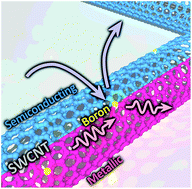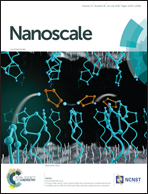Effect of boron doping on the electrical conductivity of metallicity-separated single walled carbon nanotubes†
Abstract
We explored the effect of substitutional boron doping on the electrical conductivity of a metallicity-separated single walled carbon nanotube (SWCNT) assembly. Boron atoms were introduced into semiconducting (S)- and metallic (M)-SWCNT assemblies using high temperature thermal diffusion and the concentration of the doped boron atoms was controlled by the thermal treatment temperature. Depending on the conduction mechanism of the SWCNT assembly, both positive and negative effects upon boron incorporation are observed. For the S-SWCNT sheet, the electrical resistivity decreased by about 1 order on introduction of a small amount of boron atoms, due to the localized state for hopping conduction. In contrast, we observed an increase in the electrical resistivity on boron doping for M-SWCNTs. The pristine and boron doped metallic SWCNTs exhibited a tendency of decreasing electrical resistivity in the presence of an external magnetic field perpendicular to the film, which indicated two-dimensional weak localization behavior. A detailed analysis of the resistivity and the magnetoresistance implied that an increase in the inelastic scattering event at the doped boron site reduced the phase coherence length, leading to an increase in the electrical resistivity.



 Please wait while we load your content...
Please wait while we load your content...